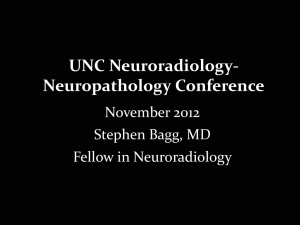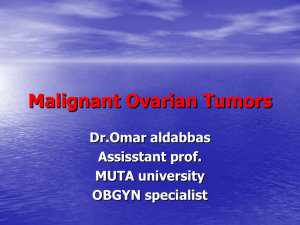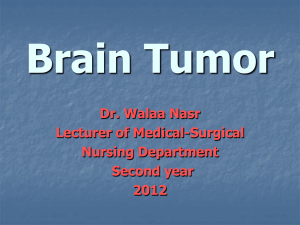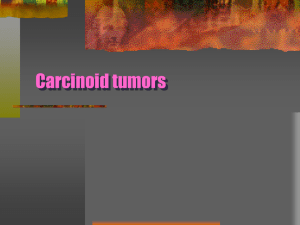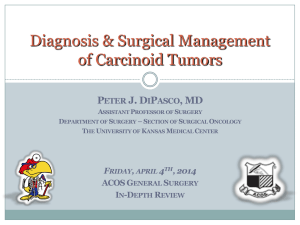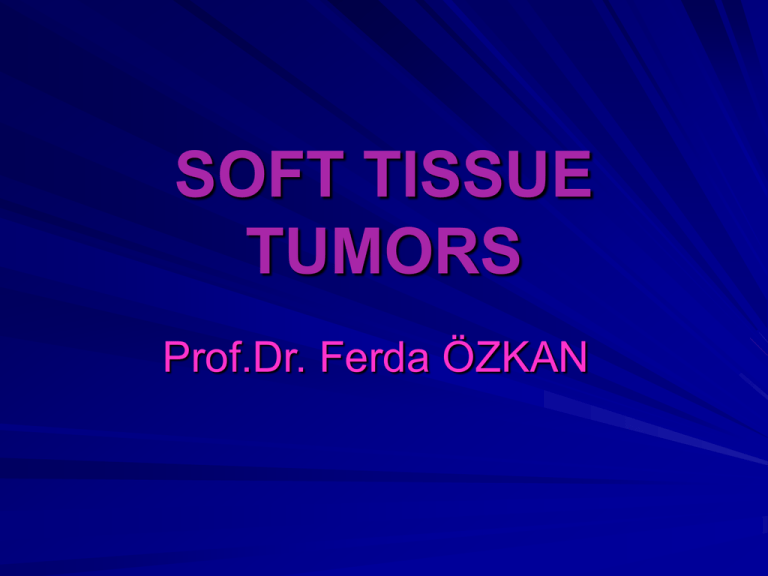
SOFT TISSUE
TUMORS
Prof.Dr. Ferda ÖZKAN
OBJECTIVES
To define soft tissues
Decribe the types of soft tissue
tumors
SOFT TISSUE TUMORS
Soft tissue tumors are defined as
mesenchymal proliferations that occur in
the extraskeletal, nonepithelial tissues of
the body.
SOFT TISSUE TUMORS
They are classified according to the
tissue they originate such as muscle,
fat, fibrous tissue, vessels, and
nerves.
SOFT TISSUE TUMORS
1.
2.
3.
4.
The cause of most soft tissue tumors is
unknown.
The majority of soft tissue tumors occur
sporadically, but a small minority is associated
with genetic syndromes
neurofibromatosis type 1 (neurofibroma,
malignant schwannoma),
Gardner syndrome (fibromatosis),
Li-Fraumeni syndrome (soft tissue sarcoma),
Osler-Weber-Rendu syndrome (telangiectasia)
SOFT TISSUE TUMORS
There are documented associations,
between radiation therapy and rare
instances in which chemical burns,
thermal burns, or trauma were associated
with subsequent development of a
sarcoma.
SOFT TISSUE TUMORS
Exposure to phenoxyherbicides and
chlorophenols has also been implicated in
some cases.
Kaposi sarcoma is causally associated
with the human herpesvirus 8; (viruses are
probably not important in the pathogenesis
of most sarcomas)
SOFT TISSUE TUMORS
Soft tissue tumors may arise in any location,
approximately 40% occur in the lower
extremities, especially the thigh;
20% in the upper extremities;
10% in the head and neck;
and 30% in the trunk and retroperitoneum.
Regarding sarcomas, males are affected more
frequently than females , and the incidence
generally increases with age.
SOFT TISSUE TUMORS
Tumors of adipose tissue
Lipomas
Liposarcoma
Tumors and tumor-like lesions of
fibrous tissue
Nodular fasciitis,
Fibromatoses
Superficial fibromatoses
Deep fibromatoses
Fibrosarcoma
Fibrohistiocytic tumors
Fibrous histiocytoma
Dermatofibrosarcoma protuberans
Malignant fibrous histiocytoma
Tumors of skeletal muscle
Rhabdomyoma
Rhabdomyosarcoma
Vascular tumors
Hemangioma
Lymphangioma
Hemangioendothelioma
Hemangiopericytoma
Angiosarcoma
Peripheral nerve tumors
Neurofibroma
Schwannoma
Granular cell tumor
Malignant peripheral nerve
sheath tumors
Tumors of uncertain histogenesis
Synovial sarcoma
Alveolar soft part sarcoma
Epithelioid sarcoma
FATTY TUMORS
LIPOMAS
Benign tumors of fat, known as lipomas, are the
most common soft tissue tumor of adulthood.
They are subclassified according to particular
morphologic features as conventional lipoma,
fibrolipoma, angiolipoma, spindle cell lipoma,
myelolipoma, and pleomorphic lipoma.
Lipomas are soft, mobile, and painless (except
angiolipoma) and are usually cured by simple
excision
FATTY TUMORS
Morphology
The conventional lipoma, the most
common subtype, is a well-encapsulated
mass of mature adipocytes that varies
considerably in size.
It arises in the subcutis of the proximal
extremities and trunk, most frequently
during mid-adulthood.
Histologically, they consist of mature white
fat cells with no pleomorphism.
FATTY TUMORS
LIPOSARCOMA
Liposarcomas are one of the most common
sarcomas of adulthood and appear in those in
their forties to sixties,
they are uncommon in children.
They usually arise in the deep soft tissues of the
proximal extremities and retroperitoneum and
developing into large tumors.
All types of liposarcoma recur locally and often
repeatedly unless adequately excised.
FATTY TUMORS
Morphology
Histologically, liposarcomas can be divided into(
atypical lipomatous tumor) well-differentiated,
myxoid, round cell, and pleomorphic variants.
Myxoid type is the most common.
The cells in well-differentiated liposarcomas are
readily recognized as lipocytes.
In the other variants, most of the tumor cells are
not obviously adipogenic, but some cells
indicative of fatty differentiation are almost
always present.
These cells are known as lipoblasts; they mimic
fetal fat cells and contain round clear
cytoplasmic vacuoles of lipid that scallop the
nucleus.
Myxoid liposarcoma
TUMORS OF SKELETAL
MUSCLE
Skeletal muscle neoplasms, in contrast to
other groups of tumors, are almost all
malignant.
The benign variant, rhabdomyoma, is
distinctly rare.
TUMORS OF SKELETAL
MUSCLE
RHABDOMYOSARCOMA
Rhabdomyosarcoma, the most common soft
tissue sarcoma of childhood and adolescence,
usually appears before age 20.
They may arise in any anatomic location, but
mostly the head and neck or genitourinary tract.
Only in the extremities they appear in relation to
skeletal muscle.
Rhabdomyosarcoma Age
Head-neck
40%
Genitourinery 20%
Extremities
20%
Sites
7%
28%
11%
2%
2%
6%
18%
2%
24%
Orbit
Head & Neck
Trunk
Intrathoracic
GI-Hepatic
Retroperitoneum
GU
Perineum-Anus
Extremities
Common Histiotypes of Rhabdomyosarcoma
60% HN-GU
Botryoid 10% Vagina-Grapelike
20% Extremities
TUMORS OF SKELETAL
MUSCLE
Morphology
Rhabdomyosarcoma is histologically subclassified into
the embryonal, alveolar, and pleomorphic variants.
The rhabdomyoblast-the diagnostic cell in all typescontains eccentric eosinophilic granular cytoplasm rich in
thick and thin filaments.
The rhabdomyoblasts may be round or elongate; the
latter are known as tadpole or strap cells and may
contain cross-striations visible by light microscopy.
Ultrastructurally, rhabdomyoblasts contain sarcomeres,
and immunohistochemically they stain with antibodies to
the myogenic markers desmin, MYOD1, and myogenin.
Rhabdomyosarcoma composed of malignant small round
cells. The rhabdomyoblasts are large and round and have
abundant eosinophilic cytoplasm; no cross-striations are
evident
Myogenin Ab-1
TUMORS OF SKELETAL
MUSCLE
Embryonal rhabdomyosarcoma is the
most common type, accounting for 66% of
rhabdomyosarcomas.
It includes the sarcoma botryoides
described in and spindle cell variants.
The tumor occurs in children under age 10
years and typically arises in the nasal
cavity, orbit, middle ear, prostate, and
paratesticular region.
Embryonal rhabdomyosarcoma
Embryonal rhabdomyosarcoma
TUMORS OF SKELETAL
MUSCLE
Alveolar rhabdomyosarcoma is most
common in early to mid-adolescence and
usually arises in the deep musculature of
the extremities.
Histologically the tumor is traversed by a
network of fibrous septae that divide the
cells into clusters or aggregates; as the
central cells degenerate and drop out, with
resemblance to pulmonary alveolae.
Alveolar rhabdomyosarcoma
Alveolar rhabdomyosarcoma with
numerous spaces lined by tumor
cells
TUMORS OF SKELETAL
MUSCLE
Pleomorphic rhabdomyosarcoma is
characterized by numerous large,
sometimes multinucleated, bizarre
eosinophilic tumor cells.
This variant is rare, has a tendency to
arise in the deep soft tissue of adults and,
as noted earlier, can resemble malignant
fibrous histiocytoma histologically.
TUMORS OF SKELETAL
MUSCLE
Rhabdomyosarcomas are aggressive
neoplasms and are usually treated with a
combination of surgery and chemotherapy with
or without radiation.
The histologic variant and location of the tumor
influence survival.
The botryoid subtype has the best prognosis,
followed by the embryonal, pleomorphic, and
alveolar variants.
Overall, approximately 65% of children are
cured of their disease, but adults fare less well.
TUMORS OF SMOOTH
MUSCLE
LEIOMYOMA
Leiomyomas, the benign smooth muscle
tumors, often arise in the uterus where they
represent the most common neoplasm in
women
Leiomyomas may also arise in the erector pili
muscles found in the skin, nipples, scrotum, and
labia (genital leiomyomas) and less frequently
develop in the deep soft tissues.
TUMORS OF SMOOTH
MUSCLE
They are usually not larger than 1 to 2 cm in
greatest dimension and are composed of
fascicles of spindle cells that tend to intersect
each other at right angles.
The tumor cells have blunt-ended, elongated
nuclei and show minimal atypia and few mitotic
figures.
Solitary lesions are easily cured; however, they
may be so numerous that complete surgical
removal is impractical.
TUMORS OF SMOOTH
MUSCLE
LEIOMYOSARCOMA
Leiomyosarcomas account for 10% to
20% of soft tissue sarcomas.
They occur in adults and afflict women
more frequently than men.
Most develop in the skin and deep soft
tissues of the extremities and
retroperitoneum.
TUMORS OF SMOOTH
MUSCLE
Morphology
Leiomyosarcomas present as pain-less firm
masses.
Retroperitoneal tumors may be large and bulky
and cause abdominal symptoms.
Histologically, they are characterized by
malignant spindle cells that have cigar-shaped
nuclei arranged in interweaving fascicles.
Morphologic variants include tumors with a
prominent myxoid stroma and others with
epithelioid cells.
Immunohistochemically, they stain with
antibodies to vimentin, actin, smooth muscle
actin, and desmin.
TUMORS OF SMOOTH
MUSCLE
Treatment depends on the size, location,
and grade of the tumor.
Superficial or cutaneous leiomyosarcomas
are usually small and have a good
prognosis,
large, retroperitoneal ones cannot be
entirely excised, and cause death by both
local extension and metastatic spread.
FIBROHISTIOCYTIC TUMORS
Fibrohistiocytic tumors contain cellular
elements that resemble both fibroblasts
and histiocytes.
FIBROHISTIOCYTIC TUMORS
BENIGN FIBROUS HISTIOCYTOMA
(DERMATOFIBROMA)
Benign fibrous histiocytoma is a relatively
common lesion that usually occurs in the
dermis and subcutis.
It is painless and slow growing and most
often presents in mid-adult life as a firm,
small (up to 1 cm) mobile nodule.
FIBROHISTIOCYTIC TUMORS
Morphology
Most benign fibrous histiocytomas consist
of a proliferation of bland spindle cells
arranged in a storiform pattern.
These tumors have infiltrative margins;
common secondary findings include the
presence of foam cells, hemosiderin
deposits, multinucleated giant cells, and
hyperplasia of the overlying epidermis
FIBROHISTIOCYTIC TUMORS
MALIGNANT FIBROUS HISTIOCYTOMA
Malignant fibrous histiocytoma refers to a group
of related soft tissue sarcomas characterized by
considerable cytologic pleomorphism, the
presence of bizarre multinucleate cells, and
storiform architecture.
Malignant fibrous histiocytoma usually arises in
the musculature of the proximal extremities and
the retroperitoneum.
Cutaneous variants have also been called
atypical fibroxanthomas.
FIBROHISTIOCYTIC TUMORS
Morphology.
These tumors are usually large (5 to 20 cm),
gray-white unencapsulated masses but often
appear deceptively circumscribed.
Malignant fibrous histiocytomas have been
categorized into storiform-pleomorphic,
myxoid, inflammatory, giant cell, and
angiomatoid variants based on their histologic
features.
The storiform-pleomorphic type is the most
common and as the name indicates is
composed of malignant spindle cells oriented in
a storiform pattern with scattered, large round
pleomorphic cells .
FIBROHISTIOCYTIC TUMORS
Most variants of malignant fibrous histiocytoma,
except for the angiomatoid type, are aggressive,
recur unless widely excised, and have a
metastatic rate of 30% to 50%.
However, cutaneous tumors rarely disseminate;
the angiomatoid variant is also indolent and in
contrast to the other types occurs in adolescents
and young adults.
Malignant fibrous histiocytoma revealing fascicles of
plump spindle cells in a swirling (storiform) pattern,
typical but not pathognomonic of this neoplasm
REACTIVE PSEUDOSARCOMATOUS
PROLIFERATIONS
Reactive pseudosarcomatous proliferations are nonneoplastic lesions that either develop in response to
some form of local trauma (physical or ischemic) or are
idiopathic.
They are composed of plump reactive fibroblasts or
related mesenchymal cells.
They are alarming because they develop suddenly and
grow rapidly;
histologically, they cause concern because they mimic
sarcomas owing to their hyper cellularity, mitotic activity,
and a primitive appearance.
Representative of this family of lesions are nodular
fasciitis and myositis ossificans.
Nodular Fasciitis
Nodular fasciitis, also known as infiltrative or
pseudosarcomatous fasciitis, is the most
common of the reactive pseudosarcomas.
It most often occurs in adults on the volar aspect
of the forearm, followed in order of frequency by
the chest and back.
Patients typically present with a several-week
history of a solitary, rapidly growing, and
sometimes painful mass.
Trauma is noted in only 10% to 15% of cases.
Nodular Fasciitis
Morphology
Nodular fasciitis lesions arise in the deep
dermis, subcutis, or muscle.
Grossly the lesion is several centimeters in
greatest dimension, is nodular in configuration,
and has poorly defined margins.
Nodular fasciitis is richly cellular and consists of
plump, immature-appearing fibroblasts arranged
randomly (simulating cells growing in tissue
culture) or in short intersecting fascicles
Nodular fasciitis with plump, randomly
oriented spindle cells surrounded by myxoid
stroma
Myositis Ossificans
Myositis ossificans is distinguished from the other
fibroblastic proliferations by the presence of metaplastic
bone.
It usually develops in athletic adolescents and young
adults and follows an episode of trauma in more than
50% of cases.
The lesion typically arises in the musculature of the
proximal extremities.
The clinical findings are related to its stage of
development; in the early phase, the involved area is
swollen and painful, and within several weeks, it
becomes more circumscribed and firm.
Eventually, it evolves into a painless, hard, welldemarcated mass.
Morphology
Grossly, the usual lesions are 3 to 6 cm in greatest
dimension.
Most are well delineated and have soft, glistening
centers and a firm, gritty periphery.
The microscopic findings vary according to the age of
the lesion; in the earliest phase, the lesion is the most
cellular and consists of plump, elongated fibroblast-like
cells simulating nodular fasciitis
Morphologic zonation begins within 3 weeks; the center
retains its population of fibroblasts; however, it merges
with an adjacent intermediate zone that contains
osteoblasts, which deposit ill-defined trabeculae of
woven bone.
The most peripheral zone contains well-formed,
mineralized trabeculae that closely resemble cancellous
bone.
FIBROMATOSES
Superficial Fibromatosis (Palmar, Plantar,
and Penile Fibromatoses)
Deep-Seated Fibromatosis (Desmoid
Tumors)
Superficial Fibromatosis (Palmar,
Plantar, and Penile Fibromatoses)
Palmar, plantar, and penile fibromatoses, more
bothersome than serious lesions, constitute a small
group of superficial fibromatoses.
They are characterized by nodular or poorly defined
broad fascicles of mature-appearing fibroblasts
surrounded by abundant dense collagen.
Immunohistochemical and ultrastructural studies indicate
that many of these cells are myofibroblasts.
All forms of superficial fibromatosis affect males more
frequently than females.
In about 20% to 25% of cases, the palmar and plantar
fibromatoses stabilize and do not progress, in some
instances resolving spontaneously. Some recur after
excision, particularly the plantar variant.
Superficial Fibromatosis (Palmar,
Plantar, and Penile Fibromatoses)
In the palmar variant (Dupuytren contracture), there is
irregular or nodular thickening of the palmar fascia either
unilaterally or bilaterally (50%).
Over a span of years, attachment to the overlying skin
causes puckering and dimpling. At the same time, a
slowly progressive flexion contracture develops, mainly
of the fourth and fifth fingers of the hand.
Essentially similar changes are seen with plantar
fibromatosis, except that flexion contractures are
uncommon and bilateral involvement is infrequent.
Superficial Fibromatosis (Palmar,
Plantar, and Penile Fibromatoses)
In penile fibromatosis (Peyronie disease),
a palpable induration or mass appears
usually on the dorsolateral aspect of the
penis. It may cause eventually abnormal
curvature of the shaft or constriction of the
urethra, or both.
Deep-Seated Fibromatosis
(Desmoid Tumors)
Deep-seated fibromatoses lie in the borderland
between nonaggressive fibrous tumors and lowgrade fibrosarcomas.
They commonly present as large, infiltrative
masses that frequently recur after incomplete
excision;
They are composed of banal well-differentiated
fibroblasts that do not metastasize.
They may occur at any age but are most
frequent in the teens to thirties.
Deep-Seated Fibromatosis
(Desmoid Tumors)
Desmoids are divided into extra-abdominal, abdominal,
and intra-abdominal, but all have essentially similar
gross and microscopic features.
Extra-abdominal desmoids occur in men and women
with equal frequency and arise principally in the
musculature of the shoulder, chest wall, back, and thigh.
Abdominal desmoids generally arise in the
musculoaponeurotic structures of the anterior abdominal
wall in women during or after pregnancy.
Intra-abdominal desmoids tend to occur in the mesentery
or pelvic walls, often in patients having familial
adenomatous polyposis (Gardner syndrome)
Deep-Seated Fibromatosis
(Desmoid Tumors)
Morphology.
These tumors occur as gray-white, firm, poorly
demarcated masses varying from 1 to 15 cm in
greatest diameter.
They are rubbery and tough and infiltrate
surrounding structures.
Histologically deep-seated fibromatosis is
composed of plump fibroblasts arranged in
broad sweeping fascicles that infiltrate to the
adjacent tissue
Mitoses are usually infrequent.
Regenerating muscle cells, when trapped within
these lesions, may take on the appearance of
multinucleated giant cells.
Fibromatosis infiltrating between
skeletal muscle cells
FIBROSARCOMA
Fibrosarcomas are rare but may occur anywhere
in the body, most commonly in the
retroperitoneum, the thigh, the knee, and the
distal extremities.
Many tumors previously considered
fibrosarcoma have been reclassified as
aggressive fibromatosis (desmoid), malignant
fibrous histiocytoma, malignant peripheral nerve
sheath tumors, or synovial sarcomas.
FIBROSARCOMA
Morphology
Typically, these neoplasms are unencapsulated,
infiltrative, soft, fish-flesh masses often having areas of
hemorrhage and necrosis.
Better-differentiated lesions may appear deceptively
encapsulated.
Histologic examination shows all degrees of
differentiation, from slowly growing tumors that closely
resemble cellular fibromatosis sometimes having
spindled cells growing in a herringbone fashion to highly
cellular neoplasms dominated by architectural disarray,
pleomorphism, frequent mitoses, and areas of necrosis.
FIBROSARCOMA
They are aggressive tumors, however,
recurring in more than 50% of the cases
and metastasizing in more than 25%.
Fibrosarcoma composed of malignant
spindle cells arranged in a herringbone
pattern
SYNOVIAL SARCOMA
Synovial sarcoma is so named because it was
once believed to recapitulate synovium, but the
cell of origin is still unclear.
In addition, although the term synovial sarcoma
implies an origin from the joint linings, less than
10% are intra-articular.
Synovial sarcomas account for approximately
10% of all soft tissue sarcomas and rank as the
fourth most common sarcoma.
SYNOVIAL SARCOMA
Most occur in patients in their twenties to forties.
The majority develop in the deep soft tissue in
the vicinity of the large joints of the extremities,
and about 60% to 70% involve the lower
extremities, especially around the knee and
thigh.
Patients usually present with a deep-seated
mass that has been noted for several years.
Uncommonly, these tumors occur in the head
and neck or the different viscera.
SYNOVIAL SARCOMA
Morphology
The histologic hallmark of biphasic synovial
sarcoma is the dual line of differentiation of the
tumor cells (i.e., epithelial-like and spindle cells).
Despite the mimicry of synovium, the tumor
cells do not have the features of synoviocytes.
The epithelial cells are cuboidal to columnar and
form glands or grow in solid cords or
aggregates.
SYNOVIAL SARCOMA
The spindle cells are arranged in densely
cellular fascicles that surround the
epithelial cells
Many synovial sarcomas are monophasic
in that they are composed of only spindled
cells or, rarely, epithelial cells.
SYNOVIAL SARCOMA
Lesions composed of spindled cells only,
are easily mistaken for fibrosarcomas or
malignant peripheral nerve sheath tumors.
Immunohistochemistry is helpful in
identifying these tumors, since the tumor
cells yield positive reactions for keratin
and epithelial membrane antigen,
differentiating these tumors from most
other sarcomas.
SUMMARY
The most common soft tissue tumor is lipoma.
The most common soft tissue sarcoma
(malignant soft tissue tumor) in the
retroperitoneal region is liposarcoma.
Malignant fibrous histiocytoma is the most
common sarcoma of adulthood.
Malignant fibrous histiocytoma is the most
common sarcoma that arises after radiation
therapy.
The most common malignant soft tissue tumor of
chidhood is rhabdomyosarcoma.
SUMMARY
Embryonal rhabdomyosarcoma is the
most common type of RMS and has the
best clinical outcome.
Alveolar RMS has the worst prognosis and
is likely to metastatize to LN.
Alveolar type RMS is the most common
RMS encountered in adulthood.
Dermatofibrosarcoma protuberans is the
borderline fibrohistiocytic tumor.
THANK YOU FOR
YOUR INTEREST ,
YOUR ENTHUSIASM ,
YOUR QUESTIONS,
AND YOUR WILLINGNESS TO
INVEST SO MUCH EFFORT
Good luck in the clinical years
FERDA ÖZKAN




